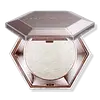Flower Beauty by Drew Stellar Prismatic Highlighter Versus Fenty Beauty Diamond Bomb All-Over Diamond Veil
What's inside
What's inside
 Key Ingredients
Key Ingredients

 Concerns
Concerns

 Ingredients Side-by-side
Ingredients Side-by-side

Mica
Cosmetic ColorantCalcium Sodium Borosilicate
Talc
AbrasiveDiisostearyl Malate
EmollientDimethicone
EmollientNylon-12
Octyldodecyl Stearoyl Stearate
EmollientAlumina
AbrasiveZinc Stearate
Cosmetic ColorantPolybutene
Caprylyl Glycol
EmollientPhenoxyethanol
PreservativeTin Oxide
AbrasiveHexylene Glycol
EmulsifyingTocopheryl Acetate
AntioxidantCI 77491
Cosmetic ColorantCI 77891
Cosmetic ColorantPolymethylsilsesquioxane
Phenyl Trimethicone
Skin ConditioningCalcium Sodium Borosilicate
Diisostearyl Malate
EmollientDimethicone
EmollientCalcium Aluminum Borosilicate
Mica
Cosmetic ColorantDimethicone/Vinyl Dimethicone Crosspolymer
Skin ConditioningPentylene Glycol
Skin ConditioningTin Oxide
AbrasiveWater
Skin ConditioningTriethoxycaprylylsilane
Polyisobutene
CI 77491
Cosmetic ColorantCI 77891
Cosmetic ColorantCI 75470
Cosmetic Colorant
 Reviews
Reviews

Ingredients Explained
These ingredients are found in both products.
Ingredients higher up in an ingredient list are typically present in a larger amount.
Calcium Sodium Borosilicate is a bulking agent. It is considered a borosilicate glass; it is composed of powder or flakes of calcium and sodium borosilicates.
This ingredient is used to add volume, shine, and color to products. You'll most likely find this ingredient in makeup products.
According to in-vivo and ex-vivo studies done by a manufacturer, this ingredient works well with UV filters:
Learn more about Calcium Sodium BorosilicateCi 77491 is also hydrated iron III oxide. It's sole purpose is to give a red/pink hue to products.
Iron III oxides are classified as inorganic chemicals for coloring.
Synthetically created Ci 77491 is considered safer than those naturally found. This is because the synthetically created version may contain less impurities. Iron oxides are generally non-toxic and non-allergenic.
Learn more about CI 77491Ci 77891 is a white pigment from Titanium dioxide. It is naturally found in minerals such as rutile and ilmenite.
It's main function is to add a white color to cosmetics. It can also be mixed with other colors to create different shades.
Ci 77891 is commonly found in sunscreens due to its ability to block UV rays.
Learn more about CI 77891Diisostearyl Malate is an emollient and most often used in lip products. It comes from isostearyl alcohol, a fatty acid, and malic acid, an AHA.
As an emollient, Diisostearyl Malate helps create a thin film on your skin to trap moisture in. This helps keep your skin soft and smooth.
Dimethicone is a type of synthetic silicone created from natural materials such as quartz.
What it does:
Dimethicone comes in different viscosities:
Depending on the viscosity, dimethicone has different properties.
Ingredients lists don't always show which type is used, so we recommend reaching out to the brand if you have questions about the viscosity.
This ingredient is unlikely to cause irritation because it does not get absorbed into skin. However, people with silicone allergies should be careful about using this ingredient.
Note: Dimethicone may contribute to pilling. This is because it is not oil or water soluble, so pilling may occur when layered with products. When mixed with heavy oils in a formula, the outcome is also quite greasy.
Learn more about DimethiconeMica is a naturally occurring mineral used to add shimmer and color in cosmetics. It can also help improve the texture of a product or give it an opaque, white/silver color.
Serecite is the name for very fine but ragged grains of mica.
This ingredient is often coated with metal oxides like titanium dioxide. Trace amounts of heavy metals may be found in mica, but these metals are not harmful in our personal products.
Mica has been used since prehistoric times throughout the world. Ancient Egyptian, Indian, Greek, Roman, Aztec, and Chinese civilizations have used mica.
Learn more about MicaTin Oxide is an inorganic oxide used to add opacity and volume to a product. In nature, it is already found in mineral form. The main ore of tin is an opaque and shiny mineral called casseterite.
Tin Oxide helps remove translucency in a product, or make it more opaque. Besides adding opacity, tin oxide is used for bulking to add volume.